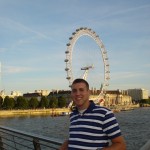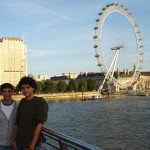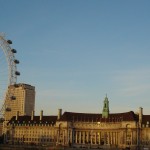Upon entering Saint-Martin-in-the-Fields, early this afternoon for the E.L.F. trio, I thought I had a pretty good idea of what to expect from the concert and the church. I’ve been in a good number of European churches, and I admit that I’ve gotten a bit jaded on the church front. I wasn’t surprised by the decor of the church (Corinthian columns, gilded decoration, chandeliers, etc). It was quite typical of a church built in the mid-1700s. I was, however, quite enthralled by the window over the main altar of the church. Unfortunately, I couldn’t take a picture of it from the church, but it seemed to be purposely distorted into a display of modern art and it certainly made an interesting juxtaposition with the existing 18th century decor and architecture. (I was unable to find more information to tell if it is an original piece of the church or a more recent addition.)
The E.L.F. trio also managed to surprise me greatly! As much as I enjoyed it, I was notexpecting a 35 minute long tribute to Andrew Lloyd Webber’s Phantom of the Opera! Anyone else have an overwhelming desire to listen to the Phantom soundtrack after that?
The National Gallery was probably the highlight of my day. Anyone who knows me really well can tell you that I love music and theatre, but I’m not one much for old paintings. We were told that when we go to the British Museum we should keep in mind how the different artefacts relate to Great Britain. Along those same lines in the National Gallery I couldn’t help but keep thinking about how the paintings managed to get to London. The ones that were by British artists or of Britain or by an artist from the Empire made sense, but how did they get such a large number of paintings from Germany, the Netherlands, Italy, etc.? What really shocked me were the 13th to 15th century paintings that used to be altarpieces in churches. There was one by Filippino Lippi, called The Virgin and Child with Saints Jerome and Dominic, from about1485 that was painted for San Pencrazio church in Florence. How did these pieces of art from the walls of churches manage to get to London? I just had a bit of an issue getting my head around the idea that so many of these fragile pieces of artwork were cut up and shipped to London museums from places that were outside of Britain’s sphere of influence.
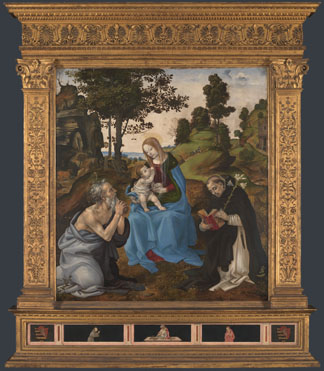
The Virgin and Child with Saints Jerome and Dominic by Filippino Lippi - picture taken from the website of the National Gallery
As I said above, I am not one who is a big fan of looking at old paintings for hours on end, but I know the big names and can recognize my fair share of famous paintings. One of the things I appreciated and was in awe of most about the National Gallery was the sheer volume of paintings they had that I was familiar with. There was one room with twenty-one paintings on the walls and I counted nine by Raphael and two by Michelangelo. (I came to realize that you could tell where a really famous painting or artist’s work was when there was a massive group of people surrounding it and traffic stopped flowing.) The US has some really nice art museums, but the content of the National Gallery blew my mind.
The main thing I learned today is that art and music transcend all language barriers. I probably heard people speaking at least a dozen different languages when I was strolling around the National Gallery and sitting in Saint-Martin-in-the-Fields, but it didn’t matter because everyone can enjoy art and it is completely open to interpretation.
Categories: Kelley
Tagged: Art, E.L.F. trio, National Gallery, Phantom of the Opera, Saint-Martin-in-the-Fields
Today’s class centered around a discussion of how immigrant and minority populations in London have either struggled or been able to assimilate. We examined specific groups and religions and attempted to define exactly what assimilation entails. Kelley brought up a great point about how some groups that come to London have no interest in assimilation. They come simply to get an education, make some money and share what they’ve learned once they return to their country of birth. This complicates the assimilation process even more. What can we do as educated young people to help minority groups achieve assimilation? Do they want our help at all? These are some questions I am going to continue to wrestle with for the remainder of my time in the U.K.
After class today I had an afternoon filled with art, both musical and visual. A lunchtime concert at historic St. Martin in the Fields featured a fantastic three man ensemble called E.L.F. Made up of a pianist Geoff Eales, french horn player Dave Lee and flautist Andy Findon the group put on an incredible performance highlighted by an extraordinary 40 minute take on Andrew Lloyd Webber’s “The Phantom of the Opera”. The music was moving and captivating throughout and at the end of “All I Ask of You” I was left with goosebumps from head to toe. As someone who played trumpet and a little bit of French Horn throughout high school I was amazed by the richness of the sound Mr. Lee produced. It was superior to anything I had ever heard performed in the past. The church’s incredible acoustics certainly had a major impact on the groups resounding sound as well turning a three man ensemble into what sounded like a full fledged orchestra. One action that took place during the concert that Brandon and I were pondering was whether it is customary for performers to exit the stage completely while the audience applauds and then return for the next number shortly after. We were unsure if this was something unique to England, unique to St. Martins in the Fields or whether the group chose to do so at their own discretion. In any event it was something we had never seen before.
After the concert Aidan, Brandon and I headed over to the National Gallery where we gazed at thousands of works of art from all different countries and time periods. I do not know much about visual art and what techniques are used to make paintings considered great but I was continually amazed and impressed by the amount of detail these artists put into their work. Even the smallest stroke of a paintbrush can change a painting entirely. We spent a number of hours inside the National Gallery gazing at everything from Van Gogh to Manet to Van Brugh. Visual art is not my forte nor my specialty but I was very impressed and would go back to the museum in a heartbeat.
After our tour of the National Gallery we headed back out to Trafalgar Square. The rain had let up and the square was alive with all kinds of people. There was protesting, dancing, singing and any number of exciting things going on. We took an abundance of pictures while in the area, attempting to catch all the excitement that was taking place as well as capturing the various monuments in the area such as Nelson’s Column and St. Martin in the Fields.
The final stop in our afternoon included a tour of the National Portrait Gallery, just down the road from St. Martin in the Fields. Inside we viewed portraits of everyone from Princess Diana to T.S. Eliot. My favorite part of the portrait gallery was the section they featured on the Bloomsbury Group. Portraits of Virginia Woolf, E.M. Forster and Lytton Strachey just to name a few were found inside this area. After going on the Bloomsbury walk the day before with Professor Qualls the information was still fresh in my mind and I was able to make connections between the tour and the exhibit. This was fascinating.
I can safely say that this has been my favorite day in London so far. A stimulating discussion, an unbelievable concert, a walk through an internationally recognized museum and time spent with friends adds up to a wonderful and busy day. I hope that the rest of our time spent in London will follow suit.
Categories: Churches and Cathedrals · Henry · Museums
Tagged: Art, Bloomsbury Group, Bloomsbury Walk, Nelson's Column, St. Martin in the Fields, The National Gallery, Trafalgar Squre
This Sunday in London the Humanities group went on a walking tour of the Tower Hill and a designated area of London built by the Romans (i.e the roman wall). The beautiful architecture seemed so distinct to London, because of this sense of organized chaos of defined by the Roman architecture mixed with the modern. Of all the places that I have ever been to in my short lifetime London buy far has the most character. London has no structure as to what any given area must look like, instead a person traveling the city would view a very diverse array of structural design, and although not in harmony with the “look” of London, still manages to define the personality of London.
As we walked the tour I could not help but compare the diversity within the building design to that of the people and different cultures that inhabit London. Being completely unaware of what the structure and the faces of London would like, I was completely surprised to see how similar in diversity London was in comparison to a large metropolitan area like New York, Chicago, or Los Angeles. People from all different regions of the world all together in one area is something I am used to seeing from where I come from, so coming to London and witnessing this same phenomenon of integration, however surprising, provided me with a sense of comfort because of how normal it felt.
However, as I mentioned before the major difference from major cities in America and perhaps most of the major cities in the world in comparison to London is the architectural structure and the randomness that is London. It is not uncommon to walk the streets of London to see a Cathedral or monument next to an insurance firm or a modern day office. Nor is it out of the norm to see a Starbucks located inside a historical monument. This theme of organized chaos that makes up this amazing city is one that is unique to that of any other place in the world, and makes me love it that much more.
However while walking through the tour of the London wall, and having read the history of London, I was surprised that I had not heard of the negative history of London. I pondered why I had not learned of London’s dark history, specifically the slave trade, and London’s role in it. Luckily later that afternoon my group visited the Docklands museum, where my curiosity would not only be satisfied, but educated.
On the top floor of the museum just past the first exhibit lies, the London African slave trade. When I tell you that this was one of the most amazing exhibits I had ever had the privilege of entering, I am only describing about 10% of how surreal this experience was. Having always learned about the slave trade as being an international event, I had only delved my knowledge to the America’s experience of it. So to actually learn about one of the world superpowers who participated in this inhumane portion of history made me challenge my views of what I had learned previously. In the exhibit they made it a point to express to the audience why they chose certain word’s in the exhibit and explained the history of the words so that the audience was able to get a sense of how important language is in this system of oppression that is slavery.
This experience has taught me so much about the world, and that there is so much more to learn. I feel so blessed to be in a position to get to learn about the world and its many different cultures in a way that others only get to dream about. I will cherish these moments forever!
Categories: Anthony · Uncategorized
Tagged: Organized Chaos, slave trade
Greenwich Adventures-August 21
I woke up this morning feeling a bit overwhelmed by the amount of activities and travel planned for the day, but immediately felt at ease as we made our way to the Thames River embankment. I enjoyed watching the scenery and different types of architecture pass by as we made our way to Greenwich, and definitely felt like a tourist while taking what seemed like hundreds of pictures of Big Ben. Since I spend much of my summers in parks in New Jersey, I felt comforted by being in what seemed to be a familiar place to me. The walk helped to wake me up as well
I was most interested by the museum dealing with the creation and use of early clocks on ships. It truly amazes me that people were able to construct such intricate and elaborate instruments by hand, without the aid of computers or modern technology. I also laughed when I read that early ships planned to calculate their position in relation to other ships by firing a rocket exactly 6440 feet in the air at exactly 12am..it seems silly, but I suppose without clocks or ways to calculate latitude/longitude, it seemed logical. I feel rather inadequate when I realize that I would have absolutely no idea how to even begin to create something like these clocks from scratch, from the plans to making the parts to the actual collaboration and execution of the instrument. I’m also impressed that sailors trusted the instruments enough to actually use them while in the middle of the ocean. I know I would be nervous about being the first one to use something so important to my travels and, in essence, vitality.
I also enjoyed the planetarium and was quite amused by the man running it. Despite the presentation’s humorous aspect, I left feeling like an insignificant part of an infinitely larger being. Although I had learned about the solar system and galaxies in elementary school, I don’t find much use revisiting that information with my English and psychology majors. I liked connecting the passage of time with the movement of planets, stars, and the expansion of space in general. While some of the information was jarring, it was certainly useful and thought provoking.
Categories: Amy · Uncategorized
It is hard to believe that a century ago, London was the center of the world of the international trade of physical goods. Not only was the London area one of the most productive manufacturers of goods in the world, but the London harbor was likely the single most important hub for international trade. It should probably come as a shock then that the London today deals with a fraction of a percent in goods that it once did. When I took visited the tour to the Docklands museum, I was struck by an extreme nostalgia for the London and also Great Britain that was actively engaged in the world market. While there were things that the British were not proud of (the list of all the slave ships that passed through London with the names of their owners and contributors was especially powerful), there was definite evidence that there was more than one British person who was disappointed with the London of today. In one corner of the exhibit, there was a map of the global trade routes that also indicated those that were most in use. In the center of the map (thanks to the British discovery of Longitude), sat London, the center for all of these goods being shipped from around the world. It should come as not shock then, when authors such as A.N. Wilson are openly hostile to the London of the 21st century, kept afloat by its massive tourist market.
Categories: Paul
Yesterday, we took a walking tour around Bloomsbury, the neighborhood that is adjacent to our own. Learning about the area was truly fascinating, and I felt so lucky to have the opportunity to see where Virginia Woolf lived, walk along the sidewalk where Charles Darwin might have walked, and experience an area that is so rich in history.
We learned that in this one small area lived; Charles Dickens, The Bonham Carters, Edgar Allan Poe, Ralph Waldo Emerson, Thomas Hodgkin, Henry James, Charles Darwin, Virginia Woolf and T.S. Eliot. In fact, we saw a building that once housed the publishing company where T.S. Eliot worked, and were told of how his wife – whom Eliot claimed was mentally unwell – would “picket” outside the building with a sign that read “I am the abused wife of T.S. Eliot!”
We walked though an area around Russell square which was destroyed during the Blitz and rebuilt years later. It was interesting, too, to see just how severe the destruction of the city was at the Docklands Museum today. The rest of the museum was very informational, as well. I particularly enjoyed the sections about the docklands themselves. Being a visual learner, I found it very useful to see all the diagrams, primary sources of life at the Docklands and other visual and kinesthetic aids that connected with our readings. In particular, I remember one of the articles mentioning how dangerous working at the docks was; how many men were killed by falling into the storage areas below deck or suffering other serious injuries. After seeing some of the chains, hooks, and other tools used by the workers, I can really see just how dangerous working on the docks was.
Attached are some pictures both of the Bloomsbury walk and the Docklands Museum…
Categories: Anya · Museums
Tagged: Docklands Museum, The Bloomsbury Group
 Picture: Names of ships, sailing ports, number of slaves on board and place of arrival; from Docklands Museum
Picture: Names of ships, sailing ports, number of slaves on board and place of arrival; from Docklands Museum
A short clip at the Docklands Museum opened up with the question: “Who are you?” It asked us to think about the feeling of being taken to a foreign place against your will to be violated, beaten, mistreated and even sold. It asked us to think about loosing everything you have ever worked for, everything you own, everything and everyone you love. The film also asked us to “consider slavery how bitter a draught and how many are forced to drink it” (from short film). I have thought about these questions multiple times before and I will never know what it was like to be in one of the 10,000 ships (as a slave) which left Britain for the Triangle Trade between 1642 and 1812.
Since my arrival in London, I have inquired about London’s dark history, the unpopular history, the history that no one wants to discuss, exactly the history on display at the Docklands. Yesterday, while at the Museum of London, as I read through a small exhibit on Apartheid I was reminded of the atrocities committed in South Africa and today I was reminded once again. Although, the small exhibit appeared to be focused on the contributions of Englishmen and women to the fight against the Apartheid government, it sparked a special interest in me. Today at the Docklands Museum, I was able to answer some of my own questions from yesterday regarding London’s role in the enforcement of segregation and the slave trade.
“The white men’s happiness cannot be purchased by the black men’s misery.” (Frederick Douglas, 1849) Indeed, Frederick Douglas was and still is correct in this statement and I think the Docklands Museum makes a great attempt to teach everyone just that. I am pleased to have learned this side of London’s history, the one A.N. Wilson would refer to as “hidden beneath the surface,” the one that Bloomsbury tells nothing of.
On our admirable tour of Bloomsbury I realized that this is a town filled with its own rich history, yet it is a history I was not too eager to learn. Even though, during the tour I was very much intrigued by the numerous Squares we visited and by the historical sites we discussed It was not my favorite place at the moment. I guess I’m not used to living and learning about a place where so many popular writers and influential people have lived in. I thought about how wealthy this area is and has been, and wealth is not something I personally admire. Regardless of my personal feelings, the town was a joy to explore and nifty to get to know, nevertheless I am almost sure there is some lost history in Bloomsbury too!
In class today Professor Qualls asked us to walk away considering the following questions: What does London do to people? and What happens when you come to London? Well, London certainly may have done something to those who sailed from the docklands towards the United States on slave ships, to the slaves themselves, to the people who fought (in London) for the end of Apartheid in South Africa and to those who were inspired and wrote their best work on the streets of Bloomsbury. London is making me questions British History, what is told as well as what remains hidden (not in our books). Now ask yourself, Who are you? and What is London doing to you?
I end with a quote from the Docklands Museum by Ottobah Cugoano (1787): “It is not strange to think, that they who ought to be considered as the most learned and civilized people in the world, that they should carry on a traffic of the most barbarous cruelty and injustice, and that many… are become so dissolute as to think slavery, robbery and murder no crime?”
Categories: Flow · Uncategorized
Tagged: Apartheid, Bloomsbury Walk, Docklands Museum
Today we took a walking tour of Bloomsbury. Before beginning I had no idea what to expect; I truly did not realize the amount of history that is so close to the Arran House. The amount of famous people who lived or worked in Bloomsbury is impressive. Whether it was John Maynard Keynes, Bertrand Russell, George Orwell or Virginia Woolf, you can’t but be impressed. I found it especially eerie that the Senate House of the University of London where Orwell worked and learned the in’s and out’s of propaganda really did give the the feeling of the “Ministry of Truth.” In the end, it is amazing to think that where you just walked could have been the same place as where one of the aforementioned individuals did so as well.
Perhaps what most interested me was the evolution of the Squares and the Square Gardens. What once was an exclusive membership reserved for only those in a particular Square now is open to everyone. It is obvious the class plays an important role throughout British history, but it fascinating to see how the dynamics of class change. I was particularly struck by a statue of Gandhi. The statue seems out of place yet shows how the British deal with their feelings about their past. Even with this, the statue was transformed into a symbol of peace and non-violence when the 7/7 attacks occurred. People gathered to mourn the attacks and lay flowers around a figure who was at one time seen as an enemy of British power. The transformation from enemy to symbol of peace and non-violence is remarkable.
Categories: Andrew F
Tagged: Bloomsbury Walk, Square Gardens
Being an individual who thrives on organization and cohesiveness I have been very pleased with how everything in this course is beginning to connect. On Sunday I was part of the Docklands group that went through the museum and saw the African slavery/triangle trade exhibit. Viewing the exhibit was a very moving and captivating experience and I was very pleased to see it brought up today as part of our discussion. We have been given ample opportunities to take what we have seen on our adventures outside the classroom these past few days and bring them into our formal class discussions and today we took advantage of that opportunity. In my perfect world this is what all learning should be like. From learning through each others blog posts/thoughts in class we will not understand everything about London but we will get a greater understanding of London than if we were all charged to study everything about the place. Receiving information in small concentrated doses has been a great way for me to really focus on one subject at a time and absorb that material. I hope that continues.
On a completely different note, Aidan, Brandon and I went on a wonderful walk around the Thames on Saturday night. We took the Underground from Goodge street to Embankment and walked around that area for a bit. During our stroll we saw a lot of people dressed up in eclectic garb, singing, dancing and gyrating. One of the most entertaining moments of the night was when a group of five women dressed in matching skimpy maid outfits climbed on a boat and headed down the river. Four of the women were in their 20’s and one was about 60. One thing i’ve noticed here is that People here don’t seem to care much about age differences when it comes to social life. In the five days i’ve been here I’ve seen people from vastly different generations laughing together at pubs, sharing personal stories in a park and walking hand in hand. Regardless of their age everyone seemed excited about the weekend and the prospects of a good Saturday night. The streets were packed and it was hard to move more than five feet without bumping into someone. Overall we sensed embankment to be a fairly touristy area with many American style/fast food restaurants lining the streets.
After our walk uptown we headed down to the waterfront where we made our way across the Thames by way of the Hungerford bridge. While walking over the bridge we got some fantastic pictures of the London Eye. When we finally reached the other side of the bridge we took some time to observe the variety of buskers/street performers lining the streets. While observing a jam band I was nearly “roundhouse kicked” in the face by a man who was either very intoxicated or was missing a few marbles. At this point I decided that I had heard enough of the jam band and moved on to observe a magician locking himself in a suitcase and a man break-dancing with a bicycle helmet on. Both were very talented and entertaining. I like that London requires these buskers to receive licenses in order to display their acts. This ensures that only the cream of the crop are given the chance to perform . From my own brief busking experience back in high school I know all too well that not every busker is worthy of the limelight.
After hanging around County Hall for a while we decided to head back across the Thames. We completed the loop and took Westminster Bridge back just as the sun was setting, snapping some fantastic photos of Parliament, Big Ben, County Hall and the London Eye. After walking back to Embankment We got back on the Northern Line and headed to Leicester square where we decided to grab dinner at “The Spaghetti House”. Despite the overall quality of the food we decided we would probably not go back again. The reasoning behind this decision was twofold. The first reason was the food was a bit too expensive for its quality and the second was we had two waitresses taking care of us. The latter may sound like a good thing but neither waitress knew that the other one had us covered. This simply created confusion and left us with multiple bills at the end of the night.
From this walk I took a couple things that will stick with me. I became better oriented with the waterfront and the monuments that are set around it. I also learned about both the Westminster and Hungerford Bridge and would love to learn more about the history of bridges over the Thames. Another thing that stuck with me was the vibrant personalities I experienced during our walk. Between the street performers, the eclectic characters we saw in the streets and the man that almost knocked me out with his shoe I quickly learned that London has such a variety of personalities and life experiences to offer. There is an amazing cast of characters that lives within this city. We have now become a part of that cast as well. The million dollar question is where exactly do we fit into London’s present plot both as Americans, as young people and as students? This is something I will continue to explore during the rest of my time here.
Categories: Henry · Museums
Tagged: Big Ben, Buskers, Connections, County Hall, London, London Eye, Parliament, Thames
…it’ll take you to the most unexpected places. These past two days have been extremely informative and exciting; provocative and shocking; and most of all, eyeopening. This past Sunday, as we all gathered together to take a trip back in time to the founding of Londinium, I found myself thinking about the people who walked this same land thousands of years ago. We tend to think about the older civilizations as fairly one dimensional; as a group of warriors that fight to defend their land. In fact, most of the history classes that I have taken really emphasize the importance of ancient battles, using them as markers in the timeline of the civilization’s evolution. But really, this only leaves us gaps in our knowledge, just like the gaps in the timeline. I guess ultimately, I find myself feeling unfulfilled by this sort of approach to history. What about the people, what about their fears and hopes, what about their humanity? These questions have always run through my head throughout my various history classes, yet since I have been in London, I have been pleasently surprised thus far.
We have walked the streets, learning and interacting with the history that surrounds us. I have really enjoyed seeing where influencial people have lived, walking the street where the Great Fire started…essentially being able to visualize life, to compare it to my own, to recognize their hardships and their successes.
This was especially evident on Sunday when my group headed to the Docklands to visit the museum. We were all stunned into silence as we quietly wandered from room to room which powerfully exposed the ugly truth about slavery in England. We read letters and journal entries illustrating the pain of the enslaved, we saw paintings describing the horrors, we saw the chains that bound them and held them in captivity. Basically, we saw, heard, and touched the brutality of the slave trade in London’s early history and were able to witness that same prejudice manifest itself in today’s society. This very racism was clearly seen in the comments folder that was kept inside the museum. This folder held a variety of comments; some appreciated and loved the museum for its accurate portrayal of the events that have evolved into the current lingering prejudices that plague London, as well as comments that expressed downright contempt for the museum. One I clearly remember saying, “this place is a piece of crap and i ain’t coming back”. Though the grammatical errors make this person’s comment particularly ridiculous, it shocks and angers me to see that people like this still stubbornly refuse to grasp the reality that is present. Here I was finally being able to see some kind of progress as to how we approach learning history, and yet simultaneously here was some ignorant asshole willing to skip over the potentially difficult, but nevertheless REAL, facets of English history! After this experience, my group rallied together to discuss our reactions, all of us mirroring one another’s disgust. I have to say that the comments in that little binder really struck me and I have been thinking about them ever since we left…It’s funny how one person’s bad comment can really impact an experience. With the walking tour that took place today, however, I am feeling a lot better and and again excited that we took the past and made it our present.
Categories: Maddie · Museums · Uncategorized




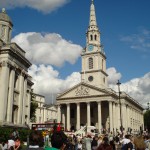

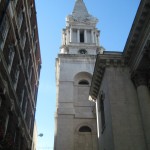
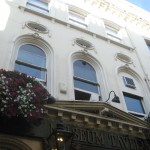
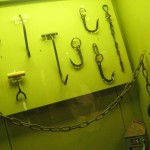
 Picture: Names of ships, sailing ports, number of slaves on board and place of arrival; from Docklands Museum
Picture: Names of ships, sailing ports, number of slaves on board and place of arrival; from Docklands Museum